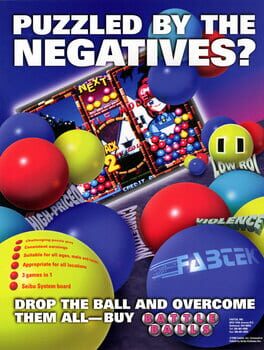

In this puzzle game, 3 rotatable balls consisting of 4 basic colors, yellow, pink, green, blue, fall from the top to the lowest part of the screen. When groups of like-colored spheres collect together, they disappear and the space is filled in with surrounding spheres. Bonuses are awarded for completing combos and the game ends when the entire screen has been filled up. The game has many modes of play: Single, Puzzle, Vs. Computer and Vs. Player. In Puzzle mode there is continuous, changing backgrounds and additional colors. In the Vs. play modes, the spheres only appear in the 4 basic colors.
Reviews View More
i actually can't rule out the possibility this game has drop tables. i've noticed differences between the number of "empty" vs. "full" balls that drop, and occasions where a player drops two colors instead of their mascot one. but the differences don't seem to matter? this game's core loop is not overly impacted, at least at my current level of play. so this game fulfills my dream! a puzzle game with primarily cosmetic character differences!
this game is certainly less angular, less brutal in its garbage curve and playstyle than a Puyo Puyo. since the playfield isn't that wide, balls tend to fall into predictable locations, and with a hex-grid, balls have more ways than ever to be connected to each other. it's gorgeously casual. it's for everybody, and i admire how open the play is.
the only element that's too complicated is the edge cases of the physics system. the whole thing, i believe, is handed: certain physics interactions will privilege one direction over the other consistently (see also early nintendo tetris games, which had LH and RH versions of the Nintendo Rotation System). it's hard to solve that elegantly, and it honestly might've been fun to make it random, although that's less friendly.
this leads me to an interesting, collarary research question: are easy and simple synonyms in puzzle game design? i certainly feel the crystallinity of spirit within this game, but does its relatively low default difficulty contribute? puyo is, like, hard, but the whole thing is so simple at its heart / base mechanics. gonna chew on this one, no answer.
great game so cute had a girl that made me lose it
this game is certainly less angular, less brutal in its garbage curve and playstyle than a Puyo Puyo. since the playfield isn't that wide, balls tend to fall into predictable locations, and with a hex-grid, balls have more ways than ever to be connected to each other. it's gorgeously casual. it's for everybody, and i admire how open the play is.
the only element that's too complicated is the edge cases of the physics system. the whole thing, i believe, is handed: certain physics interactions will privilege one direction over the other consistently (see also early nintendo tetris games, which had LH and RH versions of the Nintendo Rotation System). it's hard to solve that elegantly, and it honestly might've been fun to make it random, although that's less friendly.
this leads me to an interesting, collarary research question: are easy and simple synonyms in puzzle game design? i certainly feel the crystallinity of spirit within this game, but does its relatively low default difficulty contribute? puyo is, like, hard, but the whole thing is so simple at its heart / base mechanics. gonna chew on this one, no answer.
great game so cute had a girl that made me lose it
